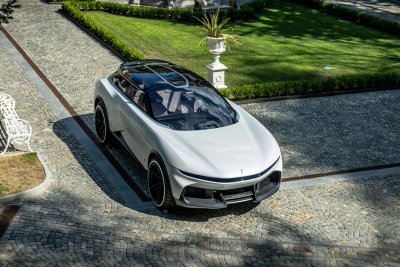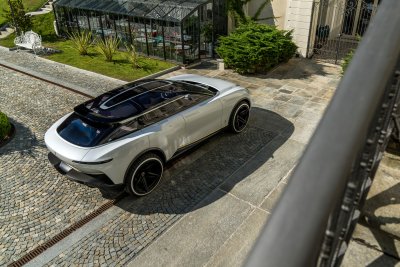Sustainability isn't just for the rich. Most of America's first electric vehicle (EV) offerings have been expensive luxury vehicles, with the exception of the Chevrolet Bolt and Nissan Leaf. As new, lower-cost vehicles have come to market, there has been a conversation shift from zero-emission vehicles (ZEVs) to carbon neutrality.
But carbon neutrality knows no socioeconomic lines. It's for everyone, for customers of bespoke Indian-owned Italian supercar outfit Automobili Pininfarina, down to the new crop of eco vehicles from Hyundai, Volvo and Mitsubishi.
Going green affects residents of areas surrounding harbors, like the Port of Long Beach, California, who are disproportionately afflicted with asthma. And those that live around the pollution that comes from manufacturing and power plants, junk yards and fuel depots.
For automakers, it's not only about designing and building new EVs, it's about a holistic approach to carbon neutrality from the top to the bottom of their operations. Toyota is among the companies that have made carbon neutrality their main goal.
While some eco advocates may point to environmentally friendly practices as the number of EVs available on dealer lots, it has more to do with the less sexy and visible elements of the business: using sustainable materials, greening shipping and logistics, treating surfaces naturally rather than with harsh chemicals, saving scrap for reuse, and taking plastic out of the ocean to give it a new life.




Automobili Pininfarina is at the top of the market. The company, founded by famed designer Battista "Pinin" Farina in 1930, has created bespoke sports car builds from its founding.
Its Pininfarina Battista is a supercar by all measurements, but it uses four electric motors at the wheels delivering 1,877 horsepower (hp) instead of a gas-burning internal combustion engine. It's not just the motive force that's sustainable, it's the entire vehicle.
"As guardians of the Pininfarina brand, we will never compromise on the design values that made this marque famous in the past. Yet as pioneers of a new era in luxury, we will apply our expertise to ensure that sustainability is at the core of the automotive art forms of the future," Dave Amantea, Chief Design Officer at Pininfarina told Newsweek.
Pininfarina uses fallen olive tree leaves that are collected and used to tan the leather it puts into vehicles, making each piece unique. Because this technique is used, the leather is traceable. The process is checked and certified every year by an independent commission.

The company says nothing is wasted in this process, with the scraps being collected and sent to a company called Authentic Material, to be reconstituted and incorporated into future vehicles. It does the same with aluminum. The scraps are collected, melted down and reformed to be featured again.
Even the material used in the floormats protecting the surface of the footwell is sustainable. It's created in a material called Econyl, by a company that collects plastics found in the ocean and converts them into durable, high-quality textiles.
Volvo's new electric vehicle, the EX30 SUV, goes beyond its powertrain being designed from scratch to have the smallest carbon footprint over the course of its lifetime. With a total footprint now below 30 tons of carbon dioxide (CO2), it beats Volvo's C40 and XC40 over a lifetime by 25 percent.
And, Volvo expects those improvements to inform its future vehicle as well in an effort to reduce its CO2 emissions by 40 percent per car between 2018 and 2025.

The 2024 EX30 uses about 17 percent recycled plastics overall, including interior and exterior parts. It was also built in a factory powered by 100 percent climate-neutral electricity. Of Volvo's Tier 1 suppliers, 95 percent have committed to all renewable energy in their production by 2025.
In addition to recycled plastic, it also uses denim, flax, and a wool-blend that contains around 70 percent recycled polyester in the cabin. Much of that is recycled from waste and scraps.
Even Mitsubishi, who sells one of the smallest, most affordable and fuel-efficient non-hybrid on the market, is getting into the action. In March it started its latest three-year plan to first increase profit, but also reduce its global carbon footprint.

The plan includes rolling out 16 models (including nine hybrids or battery electric vehicles), reducing emissions of greenhouse gases in order to help achieve carbon neutrality, investing a total of 210 billion yen by 2030 to procure 15 gigawatt-hours GWh of battery power and put more effort behind using assets unique to an automobile manufacturer (energy management, battery reuse, data sales, etc.). The company is currently part of the Renault-Nissan-Mitsubishi Alliance, which allows for shared product development, resource procurement, parts and manufacturing as a way of cutting costs.
"In its recently announced Midterm Plan – 'Challenge 2025' – MMNA's parent company, Mitsubishi Motors Corporation (MMC), has committed to accelerating its efforts toward a sustainable carbon-neutral future, setting goals of 40 percent reduction in vehicle CO2 emissions and 50 percent reduction in operational CO2 emissions by 2030," Jeremy Barnes, senior director, communications and events at Mitsubishi told Newsweek.
"Additionally, MMC has set targets for global sales of electrified vehicles at 50 percent by 2030 and 100 percent by 2035, leveraging a blend of plug-in hybrids (PHEV), hybrids (HEV) and pure electrics (BEV)."
The company also noted the Mirage's fuel mileage (an Environmental Protection Agency-estimated 39 miles per gallon combined) and that the Mitsubishi Outlander Plug-in Hybrid was the world's first PHEV SUV, as well as being the world's best-selling PHEV SUV.
Uncommon Knowledge
Newsweek is committed to challenging conventional wisdom and finding connections in the search for common ground.
Newsweek is committed to challenging conventional wisdom and finding connections in the search for common ground.
About the writer
Jake Lingeman is the Managing Editor for the Autos team at Newsweek. He has previously worked for Autoweek, The Detroit ... Read more





